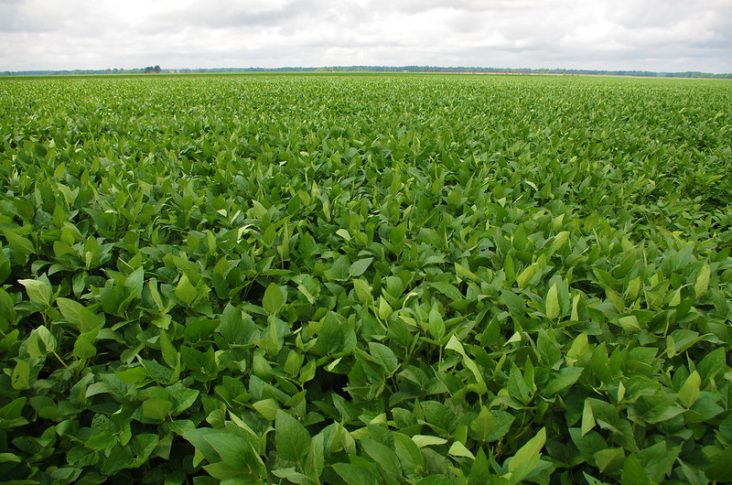Scientists developing drought and wet tolerant soybean varieties
by October 26, 2022 12:53 pm 719 views

Photo courtesy of Arkansas Farm Bureau.
Drought has been a major problem for Arkansas farmers this year, and if climate prediction models are correct it will be a major problem in the coming years and decades. The Natural State is fortunate that water aquifers in the Delta have water whereas in other states water is not abundantly available.
The models also indicate that in some years there might be too much rain and that can be a problem for growers, too.
Even with water available, farmers will have to find new ways to grow crops with less water. Researchers at the University of Arkansas System Division of Agriculture’s Experiment Station are attempting to find better ways to grow crops in these vastly differing environments.
Development of drought-tolerant soybean varieties will increase sustainability and economics of production, but current research indicates these varieties may perform poorly in the absence of drought. Agriculture scientist Dr. Larry Purcell has his sights set on what he considers an ideal genotype — soybean varieties that can grow well in both dry and water-rich environments.
Purcell has collaborated with plant scientists in Mississippi, Missouri and Arizona to use a groundbreaking method of finding soybean genotypes that can adapt to both dry and wet environments.
The focus of this research is on water use efficiency, which is a key trait when it comes to evaluating drought tolerance, but measuring it in the field is challenging, Purcell said. Water use efficiency is the ratio of photosynthesis to transpiration, or the amount of dry matter produced divided by the amount of water used in a certain time period.
To find soybean varieties that can adapt to both environments and have what scientists call “plasticity,” the researchers measured the ratio of two isotopes of carbon — carbon-13 to carbon-12 — in a large number of soybean genotypes. Carbon-13 is a slightly heavier isotope than carbon-12, the most common form of carbon.
“Trying to measure water use efficiency in the field is incredibly difficult,” Purcell said. “You’d need some sort of weighing mechanism in the soil looking at water loss, and then sample the plants, and that’s impossible to do on a large scale. The carbon-13 ratio is tightly associated with water use efficiency and gives us a handle on how to look at water use efficiency indirectly.”
While a genotype that has high water use efficiency is great in a low-water environment, its productivity typically decreases in a water-rich environment. A soybean that can adapt to different environments would be favorable in areas that experience drastic swings in weather brought on by climate change, Purcell said. “This is where plasticity comes in. Our goal is to have a soybean variety that can change its water use efficiency, depending upon soil moisture availability. No farmer will want to grow a drought tolerant soybean variety if it yields poorly when there is plentiful rainfall.”
With seeds from the U.S. Department of Agriculture’s (USDA) soybean germplasm collection, Purcell and his team have grown about 200 different soybean genotypes from Maturity Group 4 in 11 different environmental conditions, ranging from very dry to very wet. A different set of 273 genotypes were grown in four different environments. Most of the soybean varieties grown in Arkansas are in Maturity Group 4, Purcell said. The genotypes from the USDA collection are from different parts of the world and offer the genetic diversity needed for the program to breed a high-yielding variety with plasticity, Purcell noted.
“From these large field experiments we were able to determine which genotypes always have a high water use efficiency regardless of whether it is in a drought environment or a well-watered environment,” Purcell said. “And just the opposite. We can determine which genotypes change, or are plastic, in response to that environment.”
Purcell and colleagues found the most adaptive genotype was 55 percent more “plastic” than the average genotype.
After four years spent determining the plasticity of the carbon-13 ratio among the 473 genotypes, Purcell said the next step was to search the USDA’s molecular marker database to associate plasticity with specific regions on the chromosomes, or DNA, of soybean.
With the help of USDA scientists in 2010, the United Soybean Board (USB) began a process of mapping the soybean genome, identifying 50,000 different molecular markers on their entire collection of about 19,000 soybean genotypes.
“This kind of work would’ve been impossible 20 years ago because we wouldn’t have had the molecular tools to do it. It’s foresight from soy checkoff leadership that really allowed this kind of research to take place,” he said. “The USB recognition that improving drought tolerance was critical for sustainability, and its generous funding, has made this research possible.”
“Knowing the molecular markers associated with carbon-13 ratio plasticity allows a shortcut for breeding this trait into high-yielding varieties,” Purcell said.
“We are not using anything transgenic,” Purcell said. “Everything is moved from one variety, one genotype to another, by traditional crossing. The molecular part comes in how we can screen for it.”
“This research has been a fantastic, collaborative project that has pulled together a group of agronomists, crop physiologists, soybean breeders, and molecular geneticists,” Purcell said.
Arkansas farmers were projected to harvest a little more than 3 million soybean acres in 2022.
Soybeans are forecast at 167 million bushels, down 1% from the August forecast but up 9% from last year, the U.S. Department of Agriculture reported. Yield is expected to average 53 bushels per acre, unchanged from last month but up two bushels from last year. Planted acreage has been revised to 3.18 million acres, down 20,000 acres from June. Harvested acreage has been revised from 3.17 million to 3.15 million acres.
